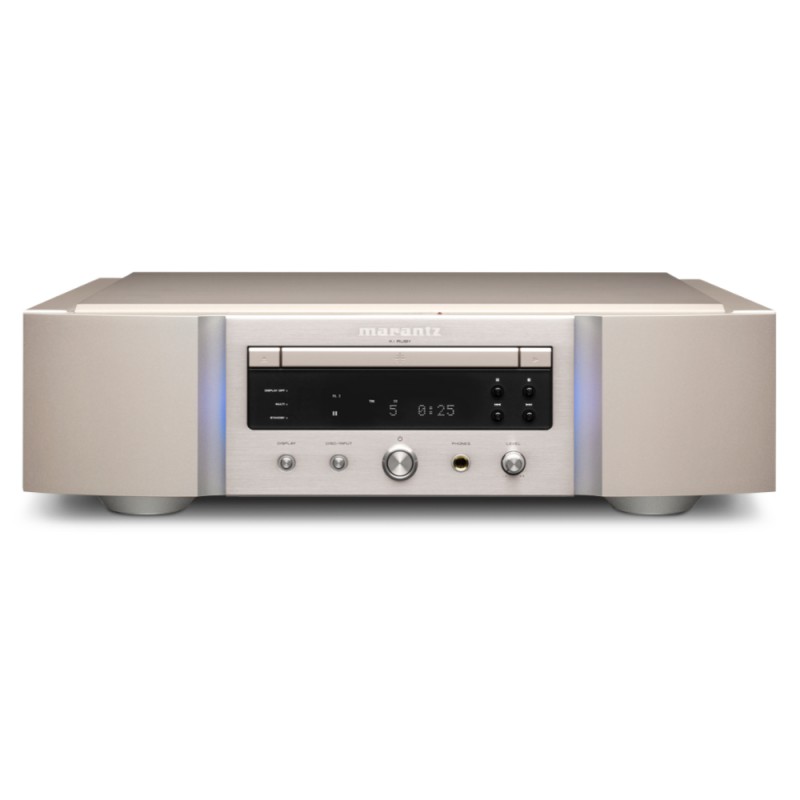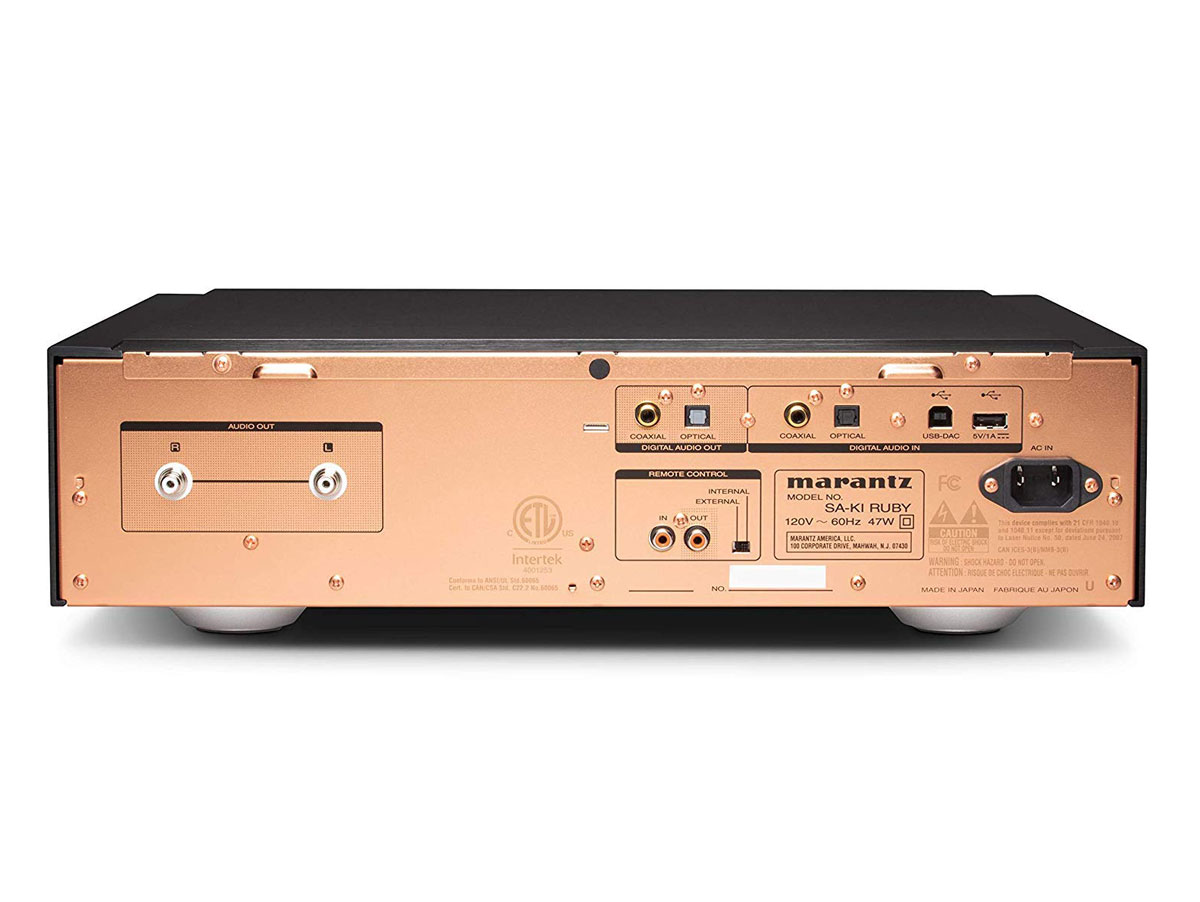Hardware Review

It’s been more than 20 years since I last had the pleasure of unpacking a new piece of hi-fi kit for review. And a lot has changed during that time. For instance, even the actual act of unboxing seems to have become an entertainment itself, given the number of YouTube videos out there that have clocked up thousands of views simply because some androgynous presenter is gleefully opening the latest toy or gadget.
More significantly, it seems that no one owns anything these days. Music, films, books and even clothes are all now offered as subscription-based services, ready to be streamed, rented and returned. And that’s a crying shame. Because if you deny yourself the pleasure of owning your favourite music in a beautifully recorded format, you have arguably foregone the opportunity of deriving the maximum pleasure from it and experiencing it at its best.
Why all this history? Well the past is certainly relevant in the context of the SA-KI Ruby SACD player: it was developed in 2018 to commemorate Ken Ishiwata’s 40th anniversary as Marantz’s now legendary audio designer. Ishiwata tells me this is the best disc player he has ever come up with, describing it as “exceptional”. That’s certainly no mean feat when you consider the number of trophies he has helped Marantz amass over the last four decades.

So what does a CD player with a price tag way north of £3,000 buy you in the 21st century? The SA-KI Ruby is billed as a precious and rare object aimed at the collector. Only 1,000 numbered units will be made; a laser-etched copy of Ishiwata’s signature and a Swarovski crystal adorn the top of the copper-plated chassis; and it certainly looks the part in its gleaming gold finish (although our review sample was finished in black).
But any connotations of a delicate, jeweled ornament soon dissipate when you unbox the SA-KI Ruby. YouTubers be warned here: this is a brute of a machine that feels as if it has been hewn from solid metal. The Marantz tips the scales at a smidge over 17 kilos, and is also quite large, measuring 44cm wide (just over 17 inches).
That weight is partly due to a power supply with a toroidal transformer, but mainly because of the solid chassis and Marantz’s high mass SACD mechanism which is used to damp the vibrations caused by high velocity spinning discs. The fascia is simple and uncluttered featuring just the essential keys although these could have been better positioned. For example, I would have preferred the track selection and play buttons to be bigger and in more intuitive locations, such as either side of the display or under it where instead we see less often used keys such as the one for switching off the display (this also turns off the electric blue LEDs that illuminate the edge of fascia side cheeks.)

Around the back, the copper rear panel features more than your usual CD player socketry. As well as both coaxial and optical digital inputs/outputs and analogue outs, there are two USB interfaces. According to Marantz, the asynchronous USB inputs can handle formats all the way up to PCM/DXD (Digital eXtreme Definition) 384kHz/32-bit and Direct Stream Digital (DSD) 11.2MHz. The interfaces can be used to connect music sources via USB type A memory devices, while a type B socket can be used to hook-up PCs (both Windows and Mac OS are supported) to play music through the digital to analogue converter. On the subject of the latter, this is where the SA-KI Ruby comes into its own (at least on paper).
Ishiwata and his team claim to have replaced the conventional DACs used in silver disc players with a patent-pending conversion technology dubbed ‘Marantz Musical Mastering’ (MMM). According to the company, conventional digital audio converters feature a digital oversampling stage, a second oversampling stage with noise-shaping to reduce signals to one- to four-bits, and a high-speed DAC. While all these stages are needed for PCM data, Marantz says only the DAC is needed for DSD. As a result, it has replaced the signal processing element and DAC with its MMS technology for stream processing and conversion. The company goes on to explain that the PCM and DXD inputs are upconverted to DSD at 11.2MHz using the MMM-Stream converter. The high-frequency signal produced is then processed by an MMM-Conversion stage to produce the analogue output.
Marantz claims that dual system clocks ensure the “most accurate” upconversion of the incoming signal, whether it’s from a disc or the digital inputs, ranging from 44.1kHz to 12.288MHz. Sigma Delta Modulation allows a pure DSD-standard signal to be passed to the conversion section in the form of a very high-frequency stream of pulses. The design of the DSD-to-analogue filter feeds into the familiar Marantz HDAM (Hyper Dynamic Amplifier Modules) in the output stage.
At least that’s the theory. So will the Ruby shine when it comes to performance? What’s more, I am keen to find out how this modern state-of-the-art machine acquits itself when compared to another heavyweight Marantz disc spinner, my trusty old CD17 which hails from the last decade of the last century. Now while it would have been naive of me to expect a night and day difference here, a part of me was really hoping that that I was about to experience a night and day difference. But what I’d forgotten, albeit for a brief and excited moment, is that high quality hi-fi is all about unveiling veneers, and this is where the SA-KI Ruby excels.

For example, the guitars on ‘Honey’ and ‘Find My Baby’ from Moby’s 1999 album ‘Play’ have way more definition on this machine compared to its ancestor. And when Torleif Thedéen’s starts carving his cello on Bach’s ‘Suite No. 1 in G Major for Solo Cello, BWV 1007: I’ the hairs on the back of the listener’s neck begin to bristle. There's more. Load up Gregory Porter’s ‘Holding On’ and the room instantly warms up with that rich, mellifluous baritone that is delivered with clinical precision. It’s the same with Helen Jane Long’s superb piano on ‘Fallen’ from her 2018 album Perspective: the sheer control that the Marantz exhibits here keeps the listener gripped and on the edge of the seat, such is its power.
And it wasn’t long before I slipped off that edge and fell off my chair: there are subtle background vocals on Boards of Canada’s ‘Aquarius (Version 3)’ from a 1998 Peel Sessionsdisc that I heard for the first time – the CD17 just hasn’t been able to extract them for me and present them in a way that can be easily picked out. It’s hard not to be drawn in by all the power, precision and detail the SA-KI Ruby is capable of.
But for some, this may also be a downside. While this Marantz is technically superb, it does run the risk of coming across as somewhat cold and clinical, and almost too clean. It plays more to the head rather than the heart, and there are times when its performance is so analytical that you are left craving that ineffable quality where the machine disappears and all that’s left is the soundscape. For those who like their digital audio delivered in squeaky clean 3D, the SA-KI Ruby will not disappoint. For example, feed its belly with Pink Floyd’s re-mastered The Dark Side Of The MoonSACD and all the variegated subtleties and nuances that exist in this masterpiece come to life, bursting across the soundstage like a firework in climax. Mind blown. And that is certainly something worth celebrating

As a DAC
While Naz concentrated his efforts on the performance with CD and SACD I spent some time using the SA KI-Ruby as a DAC with the venerable Innuos Zenith SE network server connected to its USB input. This produced an effortlessly musical result that picked out very fine detail on everything I played. It could seem overly smooth and lacking in energy at times but putting on something truly lively in the form of Dylan’s ‘Subterranean Homesick Blues’ and it sounds like all the raucous glory is coming through. You also get big differences in scale between recordings which is always a sure sign of transparency, as is the tremendous sense of articulation it brings out in the most complex pieces. The SA KI-Ruby may be a little mellow for some tastes but it’s a sophisticated piece of audio equipment built by and for connoisseurs of sound rather than those looking for instant fireworks. With both PCM and DSD it’s a chameleon converter that adds very little of its own character to the end result and that in my book is what high fidelity should be all about.
Jason Kennedy
Type: SACD/CD player and DAC
Disc Types: CD-ROM/DVD-ROM SACD, CD, CD-R/RW, WMA, MP3, AAC
Digital Inputs: S/PDIF coaxial and optical, asynchronous USB-B, USB for iPhone/iPod, USB-A for memory device
Analogue Outputs: single ended on silver plated RCA sockets, 6.35mm headphone jack
Digital Outputs: coaxial, optical
Transport mechanism: SACD-M3 (metal)
D/A conversion: Marantz Musical Mastering Conversion + Stream
DAC IC: Marantz Musical Mastering Conversion + Stream
Digital Filter & noise shaper: DSP (Marantz)
Low Pass filter stage: Hyper Dynamic Amplifier Modules (HDAM) SA2, SA3 current feedback
Output buffer: HDAM SA3
Headphone amp: HDAM-SA2 current feedback
Sample rate USB type B in: 384kHz/32-bit
Maximum dimensions (W x D x H): 440 x 419 x 127mm
Weight: 17.1kg



